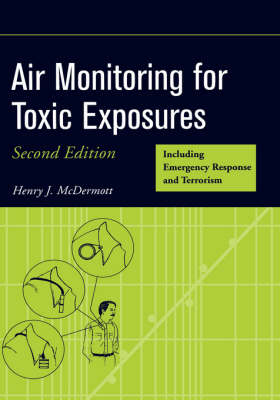
Air Monitoring for Toxic Exposures
Wiley-Interscience (Verlag)
978-0-471-45435-9 (ISBN)
Get the Latest from the Field This book offers ready-to-use information for measuring a wide variety of airborne hazardous materials including chemicals, radon, and bioaerosols. It provides the latest procedures for air sampling, collecting biological and bulk samples, evaluating dermal exposures, and determining the advantages and limitations of a given air monitoring method.
HENRY J. McDERMOTT is President and Principal Scientist for H. J. McDermott, Inc., which provides professional consulting services in the general area of occupational safety and health, with emphasis in improving safety, health, and environmental performance; risk-based preventive programs; emergency response; ventilation; litigation support; increasing safety; and health staff efficiency and impact.
PREFACE xi
PART I BACKGROUND CONCEPTS FOR AIR MONITORING 1
1 Air Monitoring Review 3
Air Sampling in Perspective 4
Air Sampling Strategy and Plan 6
Types of Air Monitoring 7
Air Sampling Techniques 10
Sample Collection Devices 11
Direct-Reading Devices 23
Monitoring Records 31
Summary 31
References 31
2 Hazards 33
Contaminants 36
Toxic Effects 46
Warning Signs 49
Standards and Guidelines for Air Sampling 52
Exposure Controls 61
Summary 66
References 66
3 Exposure Assessment Strategy and Monitoring Plan 69
Exposure Assessment 70
Performing an Exposure Assessment 73
Exposure Monitoring Plan 88
Summary 92
References 92
4 Air Monitoring at Emergencies Including Terrorism Events 93
Reasons for Air Sampling 95
Terrorism Agents 96
Identifying a Terrorism Event 100
Planning for Emergencies and Terrorism Events 101
Air Sampling for Chemical Agents 104
Air Sampling for Biological Agents 120
Air Sampling for Radiological Hazards 121
Summary 122
References 122
PART II SAMPLE COLLECTION DEVICE METHODS FOR CHEMICALS 125
5 Introduction to Monitoring Using Sample Collection Devices 127
Review of the Metric System 128
Method Selection 129
Pumps and Other Sampling Equipment 130
Understanding the Critical Orifice 133
Calibration Devices 134
Calibration Procedures 137
Sample Identification and Chain of Custody 144
Documenting Exposure Monitoring 145
Performing the Exposure Monitoring 152
Laboratory Analysis 153
Voiding Samples 155
Examples: Calculating Air Monitoring Results 156
Comparing Results to Exposure Limits 158
Summary 158
References 159
6 Sample Collection Device Methods for Gases and Vapors 161
Active Sample Collection Device Monitoring 161
Passive Collectors for Gases and Vapors 192
Summary 205
References 205
7 Sample Collection Device Methods for Aerosols 209
Characterizing Aerosols 210
Aerosol Collection Mechanisms 215
Potential Problems 219
Total Aerosol Samplers 220
Particle Size-Selective Sampling 224
Size-Selective Sampling Devices 227
Sampling for Specific Aerosols 243
Summary 251
References 251
8 Concurrent Sampling for Vapors and Aerosols 253
Collection Methods for Semivolatile Compounds 254
Collection of Multiple Species: Arsenic 260
Combustion Processes: Cigarette Smoke Collection 262
Collection of Mixtures 263
References 264
PART III REAL-TIME MEASUREMENT INSTRUMENTS 265
9 Introduction to Monitoring Using Real-Time Methods 267
Direct-Reading Instruments 268
Colorimetric Systems 293
Summary 294
References 294
10 Instruments with Sensors for Specific Chemicals 295
Calibration 298
Electrochemical Sensors 298
Metal Oxide Sensors 305
Other Detection Principles 312
Specific Chemicals 313
Summary 323
References 323
11 General Survey Instruments for Gases and Vapors 325
Measurement of Explosive Atmospheres: Combustible Gas Indicators 327
Interpretation of Measurements of Explosive Atmospheres 336
Monitoring for Health Hazard Levels of Volatile Organic Compounds: FIDs and PIDs 338
Comparison of FID and PID for General Survey Use 356
Interpretation of General Survey Measurements for Health Hazards 356
Summary 357
References 358
12 Instruments for Multiple Specific Gases and Vapors: GC, GC/MS, and IR 359
Portable Gas Chromatographs (GCs) 360
Infrared (IR) Spectrophotometers 380
Summary 395
References 396
13 Colorimetric Systems for Gas and Vapor Sampling 397
Detector Tubes 398
Long-Term Colorimetric Tubes and Badges 417
Colorimetric Electronic Instruments 421
Summary 425
References 426
14 Real-Time Sampling Methods for Aerosols 427
Light-Scattering Monitors 429
Particle Mass Measurements with the Piezobalance 439
Summary 444
References 444
PART IV MONITORING FOR AIRBORNE AGENTS OTHER THAN CHEMICALS 445
15 Radon Measurements 447
Collection Methods for Radon and Its Progeny in Air 449
Collection Method for Radon in Water 468
Interpretation of Radon Measurements 468
Performing Follow-Up Measurements (After Screening) 469
Summary 470
References 471
16 Sampling for Bioaerosols 473
Bacteria 476
Fungus and Molds 480
Viruses 481
Other Microorganisms 482
Sampling Methods and Strategies 482
Direct-Reading Instruments for Bioaerosols 500
Interpretation of Results 501
Summary 502
References 502
PART V SPECIFIC SAMPLING APPLICATIONS AND SUPPLEMENTARY INFORMATION 505
17 Specific Sampling Situations 507
Confined Spaces 507
Indoor Air Quality Investigations 511
Leak Testing: Fugitive Emissions Monitoring 532
Welding Fumes 535
Carbon Monoxide from Forklifts 537
Multiple Solvents in Printing Ink Manufacture 538
Summary 539
References 539
18 Biological Monitoring 541
Biological Exposure Indices (BEIs®) 544
Advantages and Disadvantages of Biomonitoring 545
Method Selection 546
Interpretation of Results 556
Summary 557
References 558
19 Surface Sampling Methods 561
Wipe Sampling 565
Other Surface Sampling Methods 571
Methods that Directly Assess Worker Exposure 572
Evaluating Sample Results 578
Summary 578
References 579
20 Bulk Sampling Methods 581
Purpose 581
Sample Collection Strategies 582
Containers and Shipping 585
Personal Protection 586
Bulk Air Samples 586
Bulk Samples of Solid or Liquid Chemicals 590
Soil Sampling 597
Water Sampling 602
Summary 613
References 613
APPENDICES 615
Appendix A Air Sampling Procedures 617
Dusts, Mists, and Fumes 617
Asbestos Fibers 618
Active Sampling for Organic Vapors: Adsorption Tubes 619
Gases and Vapors: Bubblers and Impingers 622
Passive Sampling for Organic Vapors: Badges or Dosimeters 623
Respirable Dust Using a Cyclone 624
Silica 626
Total Dust 627
Gasoline and Light Hydrocarbons 628
Welding Fumes 629
Benzene 632
Appendix B Gas and Vapor Calibrations 637
Premixed Gases and Vapors in Cylinders 640
Static Calibration Mixtures 641
Gas Permeation Tubes 645
References 650
Appendix C Field Calibration of Gas and Vapor Sensors 653
Step One: Setting the “Zero” Reading 654
Step Two: Span Calibration 655
Some Calibration Tools 657
Calibrating Liquid Chemical Mixtures 658
Appendix D Chemical-Specific Guidelines for Air Sampling and Analysis 659
INDEX 681
| Erscheint lt. Verlag | 5.10.2004 |
|---|---|
| Sprache | englisch |
| Maße | 187 x 260 mm |
| Gewicht | 1386 g |
| Themenwelt | Sachbuch/Ratgeber ► Natur / Technik ► Natur / Ökologie |
| Naturwissenschaften ► Chemie | |
| ISBN-10 | 0-471-45435-4 / 0471454354 |
| ISBN-13 | 978-0-471-45435-9 / 9780471454359 |
| Zustand | Neuware |
| Haben Sie eine Frage zum Produkt? |
aus dem Bereich


